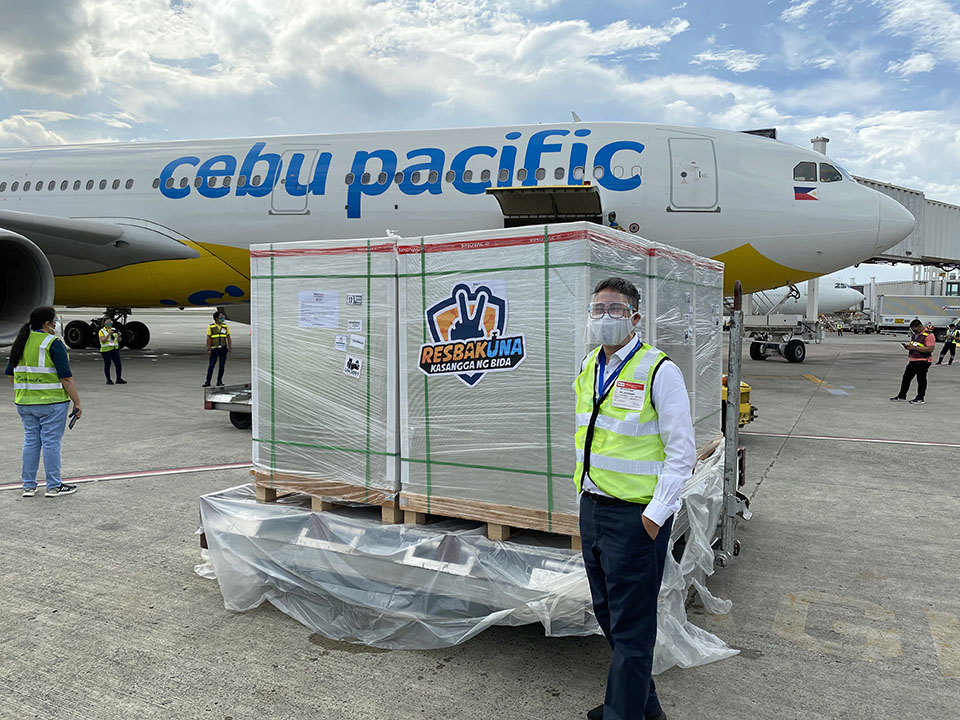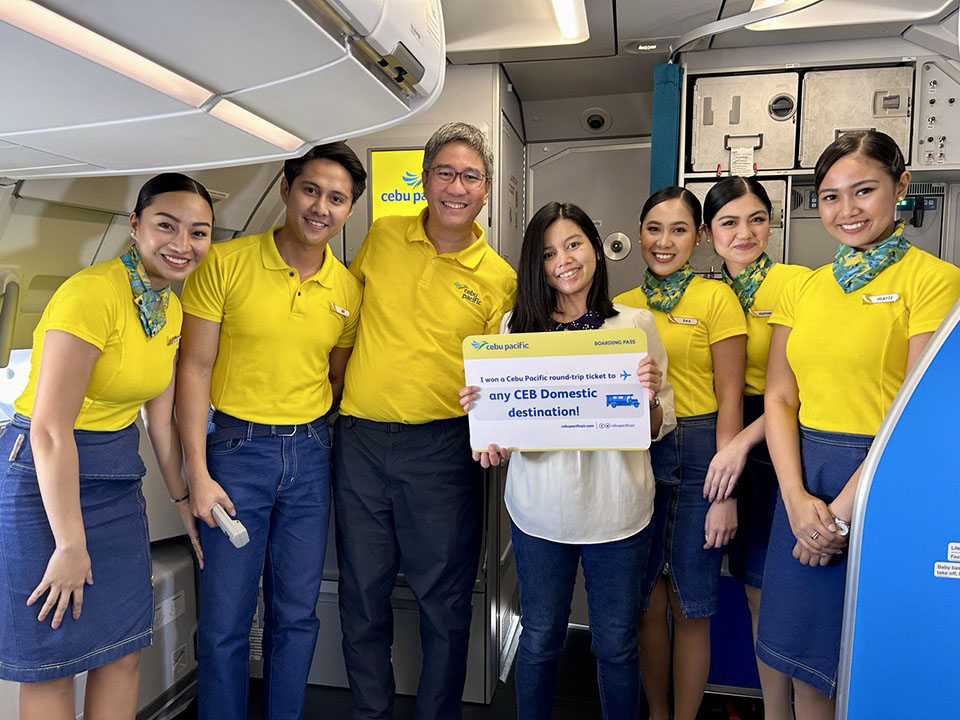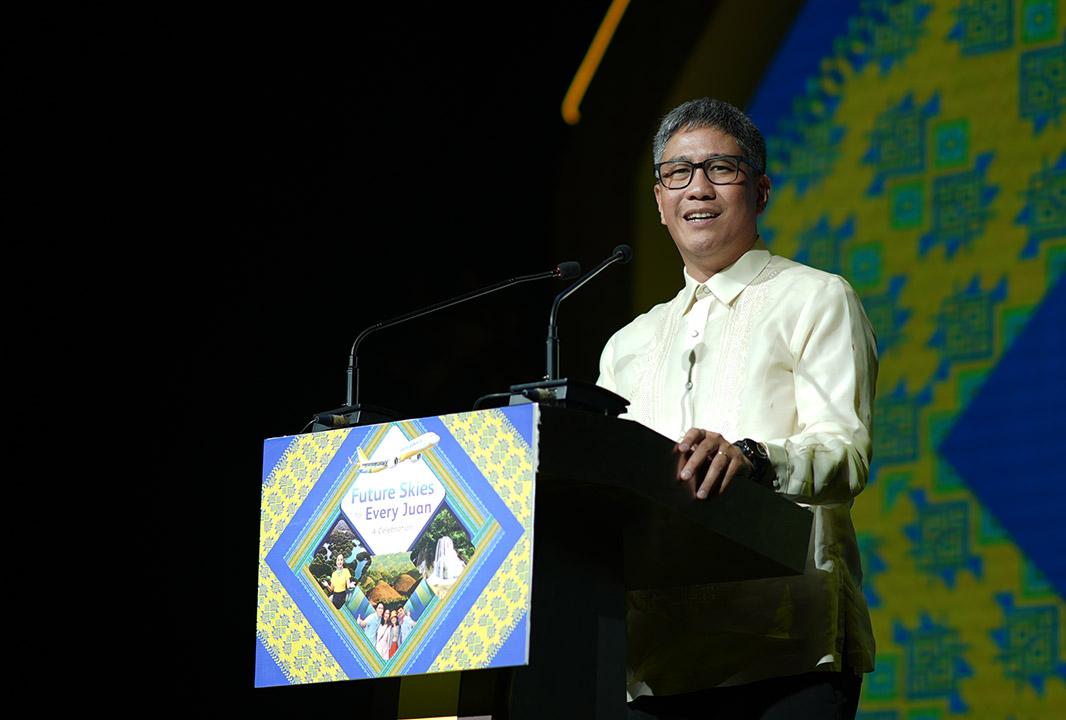Alexander “Xander” Lao’s journey as President and Chief Commercial Officer of Cebu Pacific began not in an airline hangar or a business school, but on the hardwood of college basketball courts—where his knack for numbers and patterns first took flight as the Ateneo Blue Eagles’ team manager in the mid-1990s. There, he was able to hone his instinct for stats and strategy, diligently tracking game performance with precision.
That early passion for numbers would shape a career grounded in strategic insight, relentless curiosity, and a willingness to challenge himself, learn, and adapt. Today, with nearly two decades at the country’s leading carrier, Xander has helped lead the airline through unprecedented expansion, crisis recovery, and a bold new chapter of sustainable growth.
A Career Built on Curiosity and Courage
Xander’s path into the airline industry featured some stopovers rather than a direct flight: After graduating with a degree in Legal Management in 1997, he began his career in a coffee company called Gourmet Farms as a management trainee in the Silang-based farm. “It was an interesting job because I learned how to brew coffee, plant lettuce, and cook in the kitchen. It was a fun job in the sense that we'd get to spend weekends in Tagaytay," he recalls. However, the regular work commute from Makati to Tagaytay eventually proved taxing, and after a year, Xander moved back to Manila and into the insurance industry.

His plan had always been to pursue an MBA, which he completed at the Asian Institute of Management. Afterward, he joined PhilAm Life (now AIA Philippines) and rose to the position of Assistant Vice President. Though he was already on a thriving and fulfilling career trajectory, Xander sought new challenges. A friend and classmate at AIM, Joan Cosico, already working with the Gokongwei Group, encouraged him to take a shot at Cebu Pacific to head the revenue management and pricing portfolio.
Despite having no aviation background, Xander embraced the opportunity.
His initial interview with Tim Jordan, then the head of commercial operations, was memorable. "Do you know anything about revenue management?" Jordan asked. Xander candidly replied, "Not really, but I do have an MBA and I'm pretty good with numbers."
To his shock, he was asked back for a second job interview, this time with Lance Gokongwei, then the airline’s president and CEO. He got the job.
For Xander, collaboration isn't about teamwork for its own sake—it’s about driving better outcomes through open discussion and diverse perspectives. He actively encourages his team to challenge ideas, including those from senior leadership.
As soon as he stepped into his first role as Director for Revenue Management and Pricing, Xander became immersed in the world of low-cost carriers. He credits mentors like Tim Jordan, Senior Advisor for Commercial Operations at the time, and Liza Henson, Director for Revenue Management and Pricing then, for teaching him both the technical and organizational ropes. "A lot of the principles of being an LCC were ingrained to me early on—maximum utilization, low fare strategy, a la carte pricing, direct distribution, and so on."
From there, his responsibilities expanded and grew over the years: leading Commercial Planning, serving as President and CEO of Cebgo (a CEB subsidiary focusing on domestic routes that connect smaller cities and island destinations across the country), shaping company direction as Chief Strategy Officer, and ultimately, Chief Commercial Officer (in 2021) and President (in 2023)—roles he now holds concurrently.
Leading with Vision and Humanity
As CCO, Xander is responsible for Cebu Pacific’s commercial operations—network planning, revenue management, pricing, sales, and cargo. As President, he supports CEO Mike Szucs in broader stakeholder management, strategy, and public policy. Together, they steer the airline with a collaborative leadership style.
That being said, Xander’s approach to leadership has evolved dramatically. Looking back on his early years, he admitted that fresh out of business school, he carried a mindset of 'knowing everything'—an attitude he now recognizes as limiting. “You think you kind of know everything, supposedly, but you really don't," he said with a big laugh, noting how experience has taught him to listen more, question assumptions, and seek out other perspectives. "Maybe early on, I was a lot more heavy-handed... I was quite short-tempered when I was younger," he admits. "But clearly, you need to collaborate. There’s a saying, 'If you want to move quickly, you go alone. If you want to go far, you go together.'"

For Xander, collaboration isn't about teamwork for its own sake—it’s about driving better outcomes through open discussion and diverse perspectives. He actively encourages his team to challenge ideas, including those from senior leadership. Rather than passively accepting decisions from the top, Xander expects his team to speak up, debate constructively, and refine ideas together. A lack of pushback, in his view, could indicate that strategies aren’t being fully fleshed out, leading to blind spots and missed opportunities and he fully credits CEO Mike Szucs for encouraging this not just within the Cebu Pacific senior leadership team but throughout the organization. Encouraging dissent, he believes, isn’t just healthy—it’s necessary for dynamic, resilient leadership.
Surviving Crisis Without Compromise
The COVID-19 pandemic was a defining test for Xander and Cebu Pacific. Virtually overnight, travel restrictions disrupted operations, but the airline managed to chart a course through turbulence without resorting to bankruptcy, government bailouts, or lapses in obligations to passengers and suppliers.
"We’re the only airline during COVID to have not undergone bankruptcy, to have paid our suppliers through the pandemic, to have refunded customers, and to not get any government support," Xander says.
Instead, the airline turned to a mix of shareholder backing and strategic partnerships to reinforce its foundation. A $500 million fundraising initiative brought in support from trusted stakeholders and new investors alike. Half of that amount came from a stock rights offering that saw existing shareholders—led by parent conglomerate JG Summit Holdings—demonstrate strong belief in Cebu Pacific’s long-term outlook.

The other half was secured through a $250 million investment in convertible bonds from the International Finance Corporation (IFC), the IFC Emerging Asia Fund, and Indigo Partners, a private equity firm known for its investments in global low-cost carriers. The partnership wasn’t just about capital—it was a vote of confidence in Cebu Pacific’s model, leadership, and potential.
These financial maneuvers helped ensure the airline remained operational, albeit with a temporarily reduced workforce, and stayed bravely on track with its modernization plans. "COVID was really a life-changing event for this airline. And with everyone’s perseverance, sacrifice, dedication, the airline got through it," Xander reflects.
‘It’s inherent in the business to keep supporting this low-cost model, but also to make sure that we're conscious about the environment,’ he says. The airline’s adoption of Airbus NEO aircraft, electric ground support equipment, and lightweight cabin interiors reflects a philosophy of efficiency that benefits both the bottom line and the planet.
Emerging from the crisis, Cebu Pacific did more than recover—it positioned itself for long-term resilience and growth. Xander shares that the airline became profitable again in 2023, a strong sign that its disciplined strategy, lean operations, and deep understanding of the Filipino market had paid off. The airline’s return to profitability also affirmed investor confidence and allowed the company to pursue aggressive expansion and sustainability initiatives with renewed momentum.
Soaring to a Greener Future
Sustainability is not an afterthought at Cebu Pacific—it’s a business imperative. When asked how the carrier can maintain its low-cost model while investing in efficiency and more sustainable aviation practices, he says that those two ideas can, and should, exist at the same time. “It’s inherent in the business to keep supporting this low-cost model, but also to make sure that we're conscious about the environment.”
The airline’s adoption of Airbus NEO aircraft, which burn 15–20% less fuel than previous-generation jets, has significantly reduced its carbon footprint. Lightweight, pre-reclined seats—designed without traditional mechanisms—further reduce emissions. These choices reflect a philosophy of efficiency that benefits both the bottom line and the planet.

“Our A330s have the lowest carbon emissions per passenger in Asia, if not the world. Advanced, highly efficient NEO engines, which use 15% less fuel combined with higher seating capacity, lead to the most efficient fuel burn per passenger. In contrast, a legacy carrier with a less efficient seating configuration and heavier business class seats lead to higher fuel burn and consumption per passenger,” explains Xander.
The airline recently began using electric ground support equipment and collaborates with airports drawing power from renewable sources. In 2024, it became the first low-cost carrier in Southeast Asia to secure a sustainability-linked loan—a major step that connected its financing with its environmental goals. The loan, arranged through a Japanese Operating Lease with Call Option (JOLCO), supported the acquisition of a new Airbus A321neo and was structured to benefit the airline financially for reducing its carbon emission intensity over time.
Another critical part of this journey is sustainable aviation fuel, or SAF—a next-generation fuel made from renewable sources like used cooking oil or agricultural waste. SAF can reduce carbon emissions by up to 80% over its lifecycle compared to conventional jet fuel, but its global supply is still limited, and it comes at a significantly higher cost. "There’s so little supply, so the price of SAF can be up to four times more than regular jet fuel," notes Xander.'
‘Air travel really is a multiplier for growth. According to an IATA report, for every one airline job, we create 25 other jobs—many in tourism,’ shares Xander. He points to places like Siargao as proof. Once dismissed as an impractical route, it’s now a thriving global destination, thanks in part to Cebu Pacific’s early belief in its potential.
Even so, Cebu Pacific has started incorporating SAF into its operations—using it for new aircraft delivery flights and showcased its use on select commercial flights—as a way to pilot cleaner aviation practices and raise industry awareness.
"Our role as the leading airline in the Philippines is to help develop more SAF awareness and hopefully, supply," asserts Xander. In his eyes, bringing attention to this issue and public-private collaboration are critical to unlocking aviation’s greener future—a shared flight path toward an industry that flies more responsibly, not just higher, but wiser.
Betting on the Filipino Growth Story
In 2023, Cebu Pacific placed a monumental order for 152 Airbus aircraft—marking the largest aircraft purchase in Philippine history. For Xander, this was more than a business decision; it was a statement of confidence.
“We truly believe in the Philippine growth story. We have a young population and a growing middle class,” he shares with strong conviction. “Once the Philippines comes into true middle-class status, air travel will grow significantly."
He points to the country's demographics, geographic realities, and improving infrastructure as key drivers: “Being an archipelago is actually good for an airline,” says Xander. Compared to other modes of inter-island transport, often requiring long bus trips and ferry rides, “We make travel faster, convenient, affordable, and safer.”

With a bright future in mind, the company is expanding internationally and investing in greater brand visibility abroad. “Cebu Pacific is a great brand here in the Philippines – every Filipino knows about CEB – but it's not necessarily well-known overseas. We want to be the carrier of choice for every person, not just within the country, but for those coming to the Philippines," says Xander.
That ambition to be globally recognized came to life in a particularly meaningful way for Xander and the team, a moment he regards as one of the finest in his career.
'That was such a great moment for myself, for CEB, and clearly for the Philippines,' Xander says, recalling how the Burj Khalifa in Dubai lit up in the airline’s colors. To see a homegrown Filipino brand on the world’s tallest building, it was more than a marketing win. It was a celebration of national pride.
This took place in Dubai, where Cebu Pacific became the first Filipino company to be featured on the iconic Burj Khalifa. The event, part of a campaign to promote the airline’s growing international presence and reconnect with overseas Filipinos, was broadcast to a global audience and lit up the world’s tallest building with the colors of the Philippine flag and Cebu Pacific’s signature yellow and blue. To Xander, it was more than a marketing triumph—it was a celebration of national pride. “That was such a great moment for myself, for CEB, and clearly for the Philippines,” he said, reflecting on the emotional resonance of seeing a homegrown brand take center stage on an international landmark.
Nation-Building, One Flight at a Time
Xander views Cebu Pacific as a driver of national development—beyond transporting passengers, it connects communities, supports livelihoods, and unlocks economic potential. "Air travel really is a multiplier for growth. According to an IATA (International Air Transport Association) report, for every one airline job, we create 25 other jobs—many in tourism," he said.
For him, nation-building happens flight by flight—not just in capital cities but in far-flung towns, where improved access brings new hope, growth, and a shared sense of pride.
He points to places like Siargao as a powerful example. When Cebu Pacific first explored the idea of flying to the island in 2009, few believed in its potential as a viable commercial route. At the time, Siargao lacked significant infrastructure, had limited accommodation options, and was relatively unknown outside of niche surfing circles. But Cebu Pacific took the long view. "It was one of those routes where people asked, 'Why are we flying there?'" Xander shared.

To backtrack a bit, route development at Cebu Pacific begins with a mix of data analysis, community insight, and a commitment to national connectivity. The team studies economic activity, tourism forecasts, and passenger trends, but also listens closely to local governments and communities.
So, despite the naysayers, CEB’s belief in Siargao’s potential eventually paid off. Today, thanks to improved connectivity, the surfing haven has transformed into a world-renowned destination, generating jobs, empowering local entrepreneurs, and placing Filipino island culture on the global map. And that’s something Xander wants to see replicated in places all over the country. “The Philippines has a lot of untapped potential when it comes to tourism. When you look at our neighbors like Thailand, Malaysia, Singapore, even Vietnam, that's where you see the potential of tourism in terms of employment and the development of the economy. Tourism plays such a huge part.”
Turning Golden, Moving Forward
Though he holds one of the highest roles at Cebu Pacific, Xander’s demeanor remains approachable and grounded. During our conversation, he was dressed casually in a yellow Cebu Pacific company shirt, denims, and sneakers—a look that reflects both his accessibility and hands-on style. Tall and lean, with prematurely salt-and-pepper hair, he exudes the energy of someone who is just getting started.
Outside of work, Xander finds balance in time spent with his family—a source of strength, inspiration, and stability throughout his career. "I don't think I could have gotten this far without my wife's support," he said, mentioning that they are one year away from their 25th wedding anniversary. Married in 2001, Xander pokes fun at his priority back then—"thesis bago misis"—a joke about completing his MBA before tying the knot. His wife Melissa, whom he calls his rock, and their two children—a daughter working in digital publishing and a son currently in University in Japan—have kept him grounded through the highs and lows of professional life.

When it’s time to recharge, Xander enjoys quiet escapes to the seaside, relaxing on the weekend at their family place in Bataan. While he doesn’t gravitate to any specific sport, he finds joy in simple routines like walking every day.
This year, Xander turns 50—a personal milestone that mirrors Cebu Pacific’s renewed energy. With over 250 million passengers flown, a reinvigorated expansion strategy, and a sustainability mission in progress, the future looks bold.
As we wind up the interview, his advice to his younger self says a lot about the leader he has become. "Be curious. Ask a lot more questions. There’s no such thing as a stupid question," he said. And with the perspective that comes from experience, he adds: "Perhaps show a bit more empathy early on."
Xander Lao is still a numbers guy and through the years with Cebu Pacific, he’s become a purpose-driven executive who understands that efficiency, sustainability, and inclusion aren’t mere business objectives—they’re essential pillars of progress.
Cebu Pacific’s trajectory reflects his vision. And with Xander at the helm, the airline’s journey has many more miles to soar. — Pierre A. Calasanz


